The variety of crystals in Missouri has long made the state a quiet favorite among collectors. From surface finds to those tucked within quarries and creek beds, opportunities to uncover them stretch across the state.
You can spot everything from clear quartz to richly colored minerals that form in pockets where water once flowed. Many are revealed after heavy rains, when fresh layers of earth and gravel shift and expose new surfaces.
Learning what environments tend to hide crystals helps you understand why certain areas consistently reward patient searchers. You begin to notice how small details, like soil color or nearby rock type, often signal something worth checking.
Finding the right spot to explore can make all the difference between a few fragments and a collection that truly stands out. The next discovery might only be a few steps away!
- The extensive local experience and understanding of our team
- Input from multiple local crystal hunters and crystal collecting groups
- The accessibility of the crystal mining locations
- Safety and potential hazards when collecting
- Private and public locations
- A desire to include locations for both experienced crystal hunters and those who are just starting out
Using these weights we think we’ve put together the best list out there for those who love finding new crystals for our collections!
The Types of Missouri Crystals You Can Find
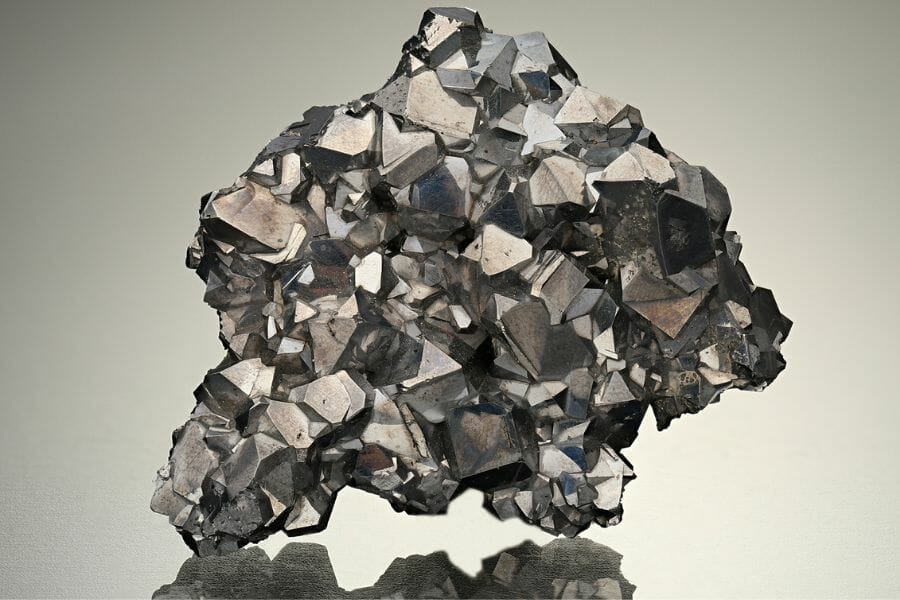
Often admired for their unique shapes, colors, and ability to refract light, Missouri crystals are found in several locations. But before you visit any of these places, you may want to know first what kinds of crystals you might find there. Here’s a great list of the crystals our state boasts of having:
Garnet
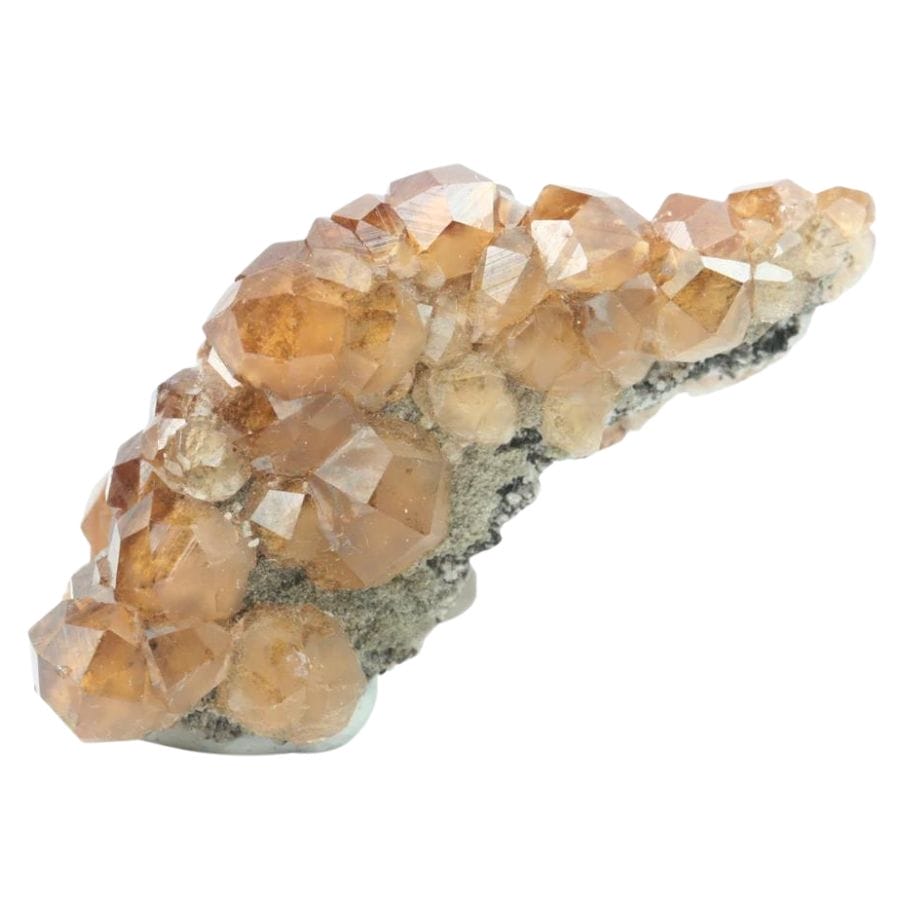
Garnet is one of those gems that really catches your eye. It has this rich, deep red color, but it can also be found in other shades like green, yellow, or even black.
This gem actually forms deep inside the Earth when certain minerals get exposed to high temperatures and pressures. Over time, these conditions change the minerals and bind them together, creating the garnet crystals that we see.
Garnet holds a special spot among the valuable rocks in Missouri. It’s not just because it’s pretty to look at. This gemstone is super durable, which makes it great for uses beyond just jewelry.
Think about sandpaper and its gritty texture. Some of it is made from crushed garnet because it’s tough and can help smooth out rough surfaces.
Where you can find garnet in Missouri
- Iron Mountain, St. Francois County
Topaz
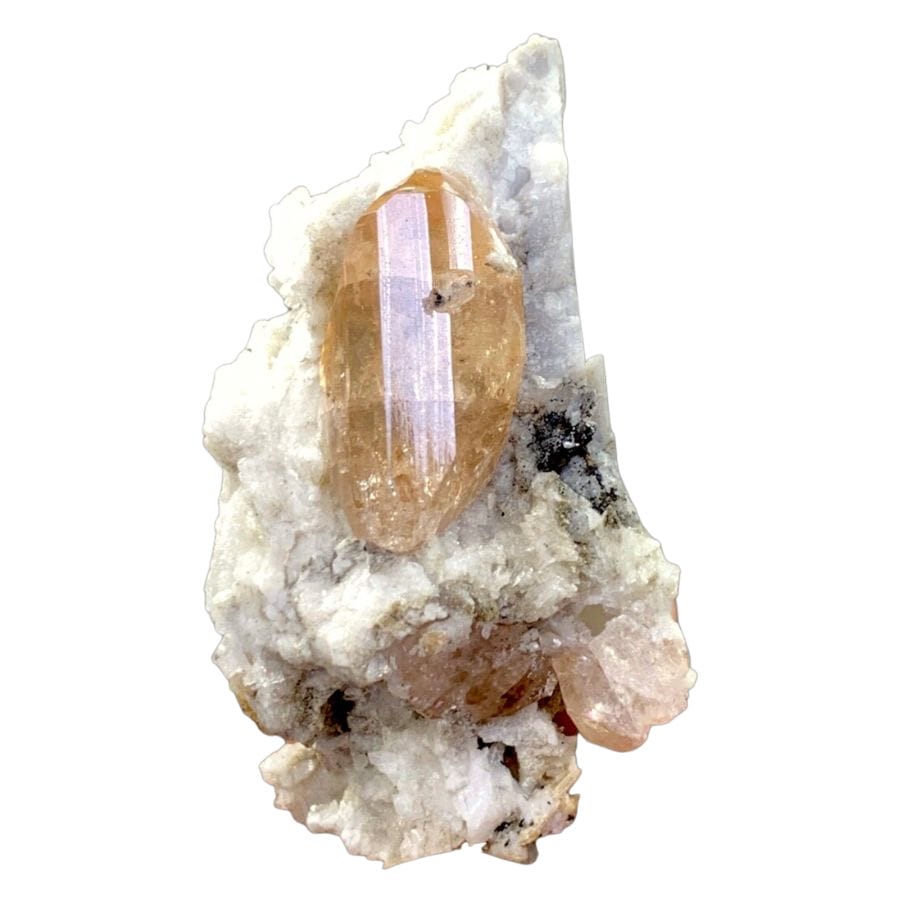
Topaz is often a clear crystal, but can sometimes have shades of yellow, blue, or even pink. This gem is more than just a pretty face; it has a cool backstory too!
Topaz forms deep below the ground in areas with a lot of heat and pressure, like near volcanoes. Here, the heat helps form a special mix of minerals, which slowly cools down and crystalizes to become topaz.
Over time, thanks to rain and rivers, some of these crystals might get closer to the surface, where lucky rock hunters can find them.
While topaz isn’t the most common find in Missouri, there are areas in the state where these shiny crystals can be spotted.
People value topaz for several reasons. First, when it’s cut and polished, it shines brightly, making it a favorite for jewelry.
Topaz is also a hard stone, which means it doesn’t scratch easily. So, whether it’s in a ring, necklace, or just in a rock collection, topaz stands out as a durable and dazzling gem!
Where you can find topaz in Missouri
- Graniteville, Iron County
- Fredericktown, Madison County
- Pea Ridge Mine, Washington County
Cerussite

Missouri is a playground for rock enthusiasts, boasting a rich tapestry of unique minerals and formations. Among the various types of rocks found in Missouri, cerussite holds a special spot in the heart of many collectors.
Cerussite is a lead carbonate mineral and often shows up in areas with lead ore deposits. What makes this mineral so captivating is its bright luster and impressive crystal structures.
Cerussite forms in the oxidation zones of lead ore bodies. When lead ore comes into contact with water and air, a chemical reaction occurs, leading to the birth of this shiny mineral.
Its crystals can look like dazzling fireworks, spreading out in all directions. These crystals are not only a treat to the eyes but also hold clues to the conditions during its formation.
People value cerussite for several reasons. Firstly, its crystal forms can be truly mesmerizing, making it a sought-after specimen for mineral collections. Additionally, studying cerussite can offer insights into the geological history of an area.
For researchers and hobbyists alike, this mineral stands as a testament to the dynamic processes that mold and shape the Earth over time.
Where you can find cerussite in Missouri
- Fox Township, Platte County
- Grand River
- Washington County
Azurite
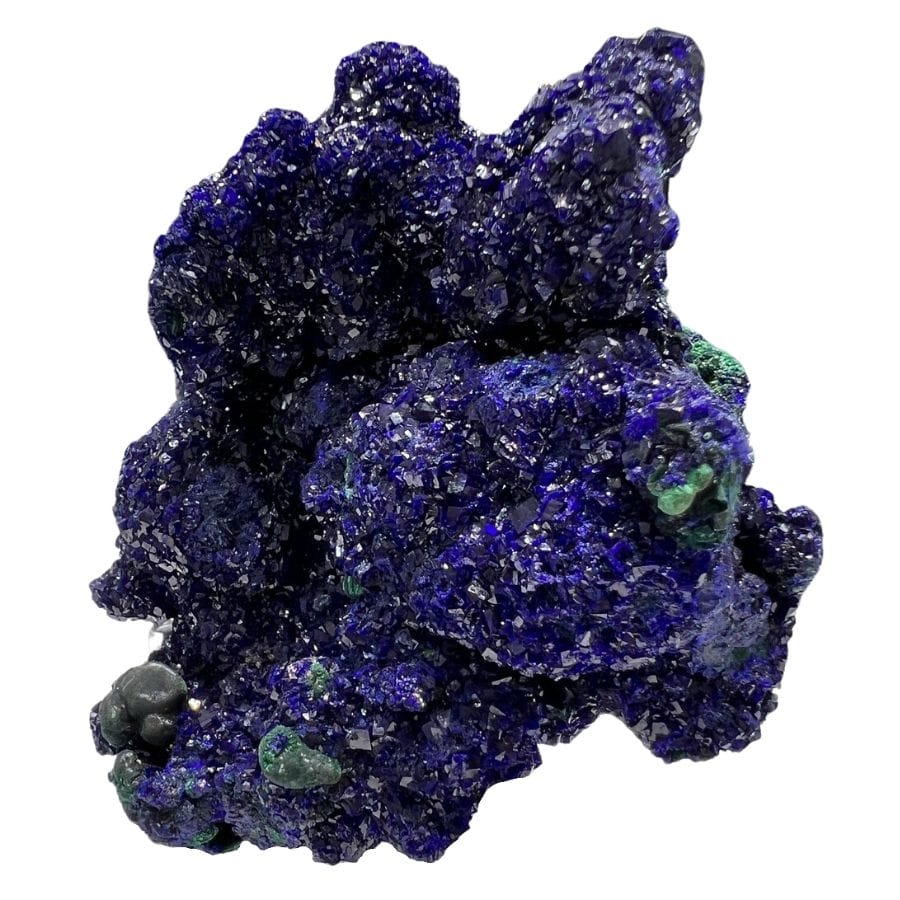
Azurite stands out from other rocks and minerals with its stunning deep blue hue. This mineral is a copper carbonate, and that rich blue color comes from the presence of copper in its chemical makeup.
Azurite forms when copper ores get exposed to oxygen and water. Over time, this exposure causes a reaction that results in the creation of azurite. It’s often found in the same areas as another mineral called malachite, which is bright green.
People value azurite for various reasons. The first and most obvious is its color. That deep blue is not only beautiful but also quite rare in the natural world. This makes azurite a favorite among mineral collectors.
Additionally, because of its copper content, azurite has been used as a source of copper metal in some places.
Where you can find azurite in Missouri
- Copper Hill Mine, Crawford County
- Cornwall Mines, Weingarten, Ste. Genevieve County
- Collins Mine, Cooper County
Magnetite
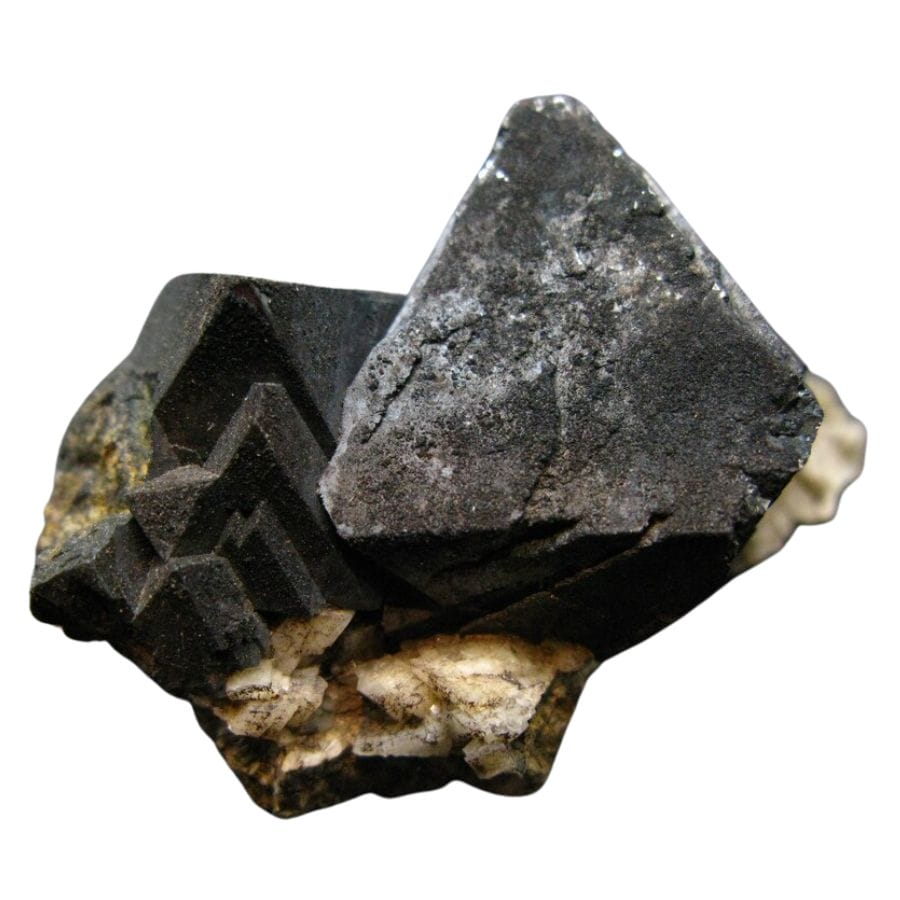
Missouri, known for its rich geological diversity, boasts a collection of minerals that capture the interest of rock enthusiasts everywhere. One such mineral is magnetite.
With its distinct dark black or iron-grey color, magnetite is easily recognized, but what really makes it stand out is its magnetic nature.
Magnetite forms in igneous and metamorphic rocks. When hot magma or lava cools down, certain minerals begin to crystallize. In environments with plenty of iron and oxygen, magnetite can form.
It can also emerge in sedimentary rocks, but it’s more commonly found in igneous and metamorphic rocks.
People find value in magnetite for a variety of reasons. For starters, its magnetic properties have been used in compasses for navigation for centuries.
Beyond that, magnetite is a major source of iron, which means it plays a big role in the production of steel.
Every time you see a building with steel beams or use a tool made of steel, there’s a good chance magnetite had a role to play in its creation.
Where you can find magnetite in Missouri
- Pea Ridge Mine, Washington County
- Iron Mountain, St. Francois County
- Pilot Knob, Iron County
Pyrite
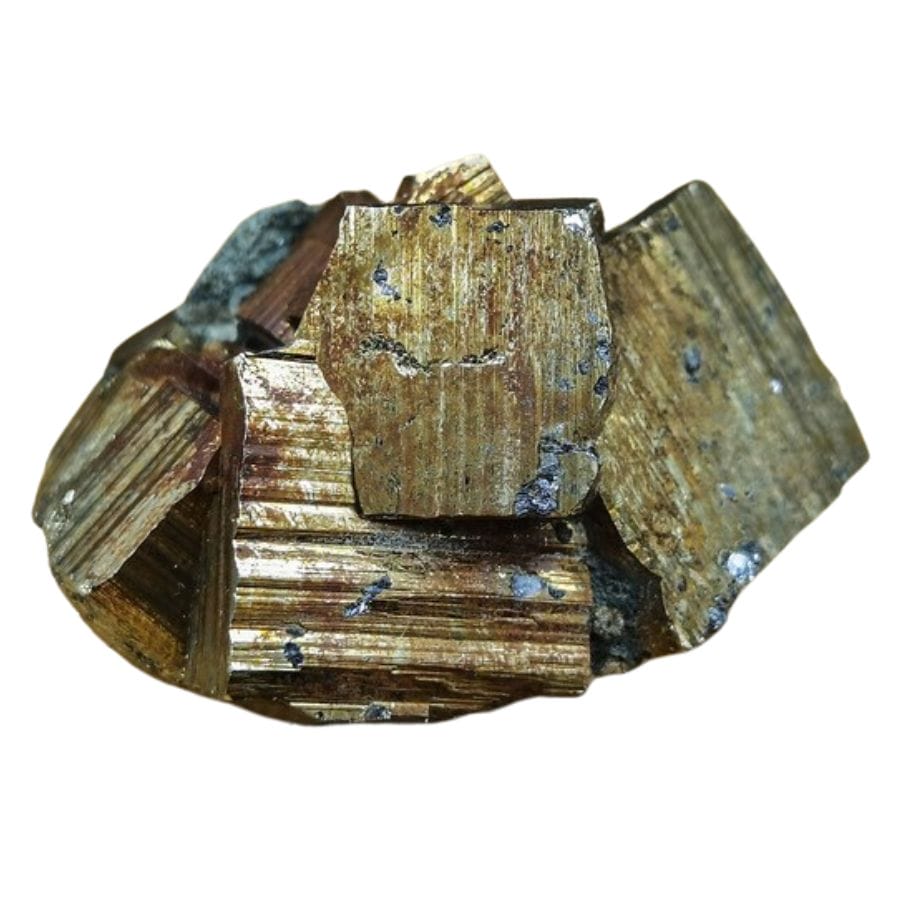
One of the standout minerals in Missouri is pyrite. Known as “fool’s gold” because of its shiny, gold-like appearance, pyrite has its own unique charm and value.
While it might look like gold at first glance, a closer look will reveal its distinct differences, such as a brighter sheen and a more brassy color.
Pyrite forms in a variety of rock environments, from sedimentary to igneous rocks. Its formation often occurs when sulfur combines with iron in the presence of a small amount of gold.
This combination creates beautiful, shiny crystals that can be cubic in shape or come as flat discs.
For many years, pyrite was used to produce sulfuric acid, a key component in batteries, fertilizers, and many other products. It’s also sometimes found in jewelry, where its bright, metallic luster can be quite appealing.
Where you can find pyrite in Missouri
- Sheffler’s Rock Shop and Geode mine, Clark County
- Buick Mine, Bixby, Iron County
- Sweetwater Mine, Ellington, Reynolds County
Fluorite
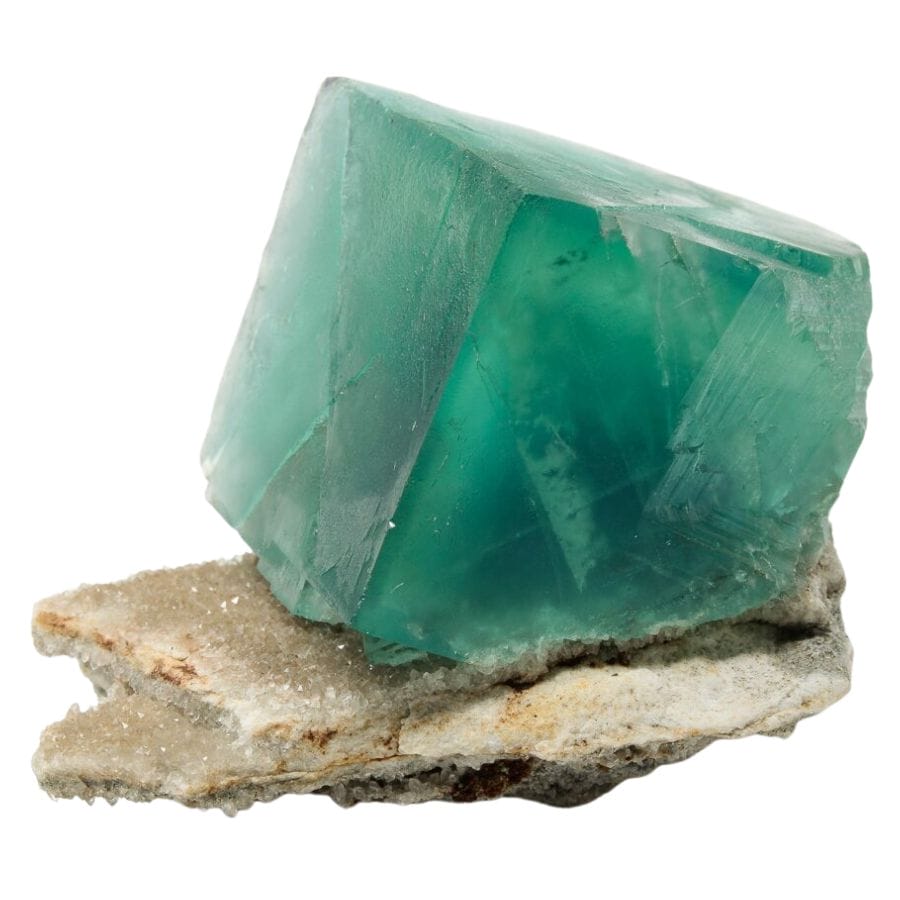
Fluorite is a mineral that can capture anyone’s attention with its stunning range of colors. From vibrant purples to cool greens and even clear crystals, fluorite showcases nature’s brilliant palette.
Fluorite forms in places where hot water circulates through rocks, dissolving certain minerals and then depositing them in cracks and cavities. As time goes on, these deposits grow and become the beautiful crystals we see.
The various colors of fluorite come from different trace elements and impurities within its structure.
Aside from its obvious beauty, fluorite has practical applications too. It’s used in the manufacture of certain chemicals and even in lenses because of its unique properties in bending light.
Collectors and jewelry makers also cherish fluorite for its stunning hues and the way it can be shaped and polished to make striking pieces.
Where you can find fluorite in Missouri
- Shepherd Mountain
- Pea Ridge Mine, Washington County
- West Fork, Reynolds County
Gypsum
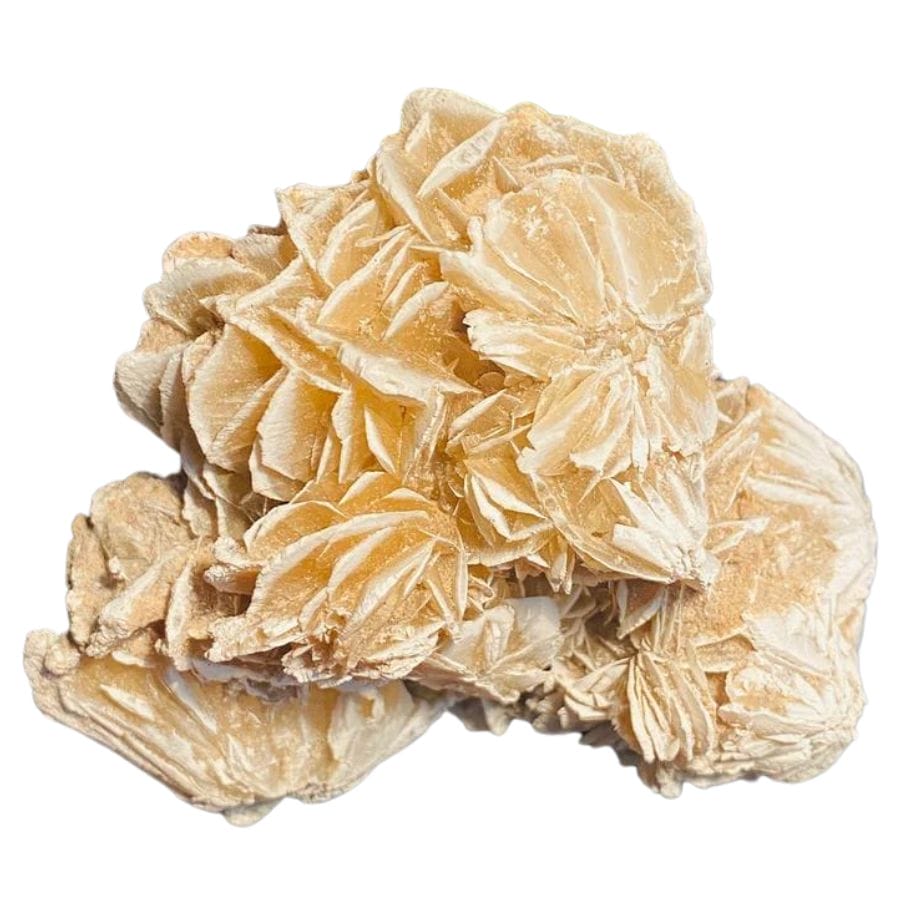
One standout mineral in Missouri is gypsum. This rock might seem plain at first, but it has some pretty cool secrets to share!
Gypsum forms in places where sea or lake waters evaporate, leaving behind this mineral. Over time, the remaining minerals build up, and voila, we get gypsum crystals.
These crystals can be clear and shiny, or they can have a soft, white appearance.
Gypsum is more than just a pretty rock. It has a softness that makes it easy to work with. Builders use it to make drywall for houses.
You might have even heard of “Plaster of Paris.” That’s a type of gypsum too! It’s used for making casts for broken bones and in various crafts.
Beyond its practical uses, gypsum also finds its way into some jewelry and decorative items because of its unique crystal shapes.
Where you can find gypsum in Missouri
- Joplin, Jasper County
- Jaeger Knob, Clarksville, Pike County
Albite
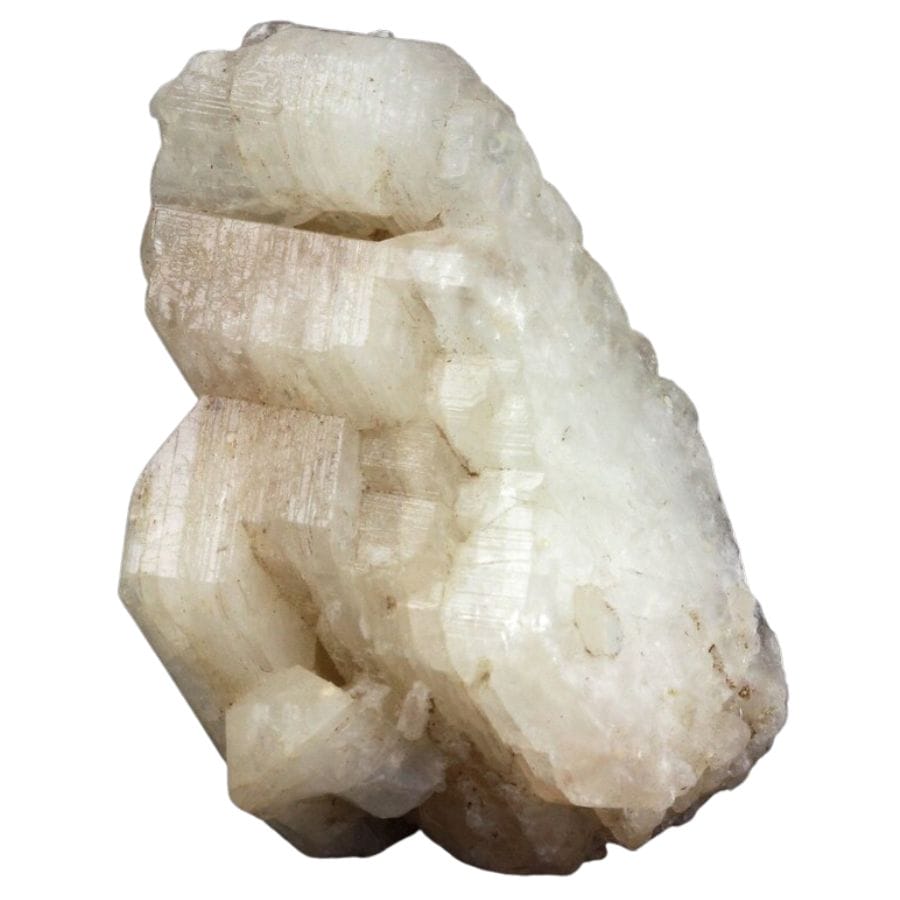
Among the cool crystals found in Missouri is albite. Albite is a mineral that may not always grab the headlines, but it’s got a story worth sharing.
Albite belongs to the feldspar family, which is a big group of minerals that are pretty common all around the world. It forms when hot molten rock, called magma, cools down and starts to harden.
As the magma cools, different minerals start to crystallize, and one of those is albite. It often appears white or colorless, but sometimes it can have a blue or green tint.
Here’s what’s super interesting about albite: it’s often found with other minerals. This means if you come across a rock with a mix of different colors and crystals, there’s a good chance albite is in there somewhere.
People value albite for several reasons. Geologists, those folks who study rocks and minerals, love to study albite because it tells them about the conditions in which the rock formed.
Plus, in some places, albite is cut and polished to make beautiful decorative items. So, while it might not be the main star of the show, albite plays an important role in the world of geology and in the stories that rocks tell us.
Where you can find albite in Missouri
- Decaturville crater, Camden County
Tourmaline
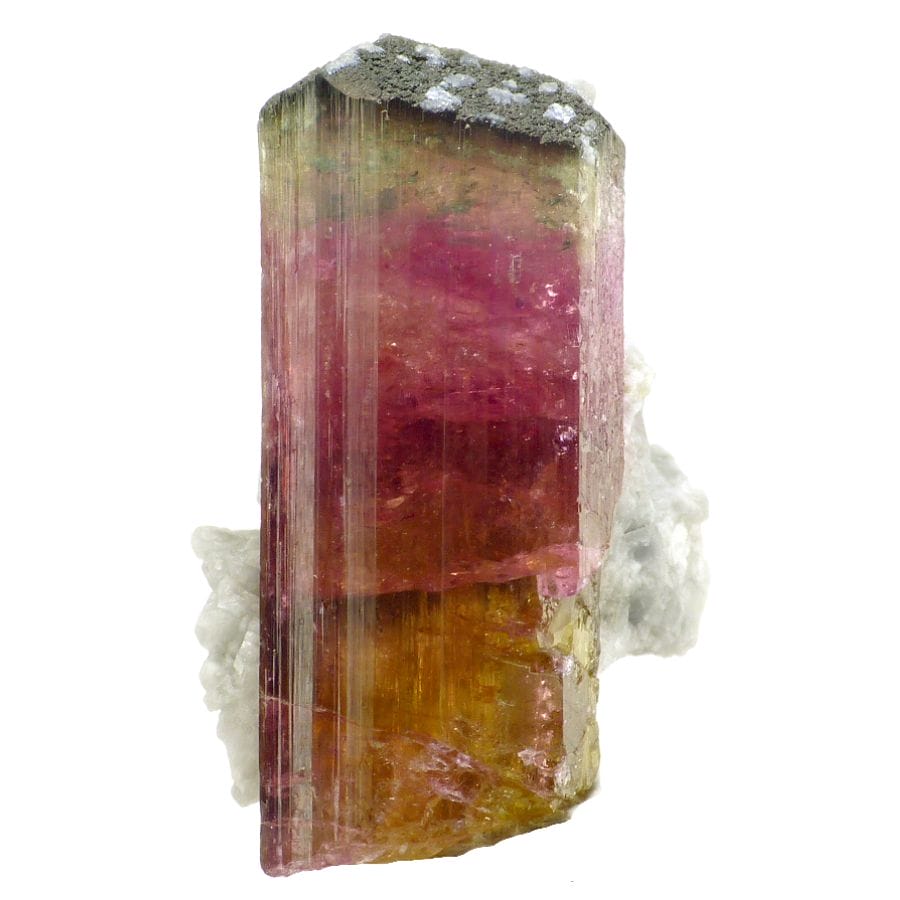
Tourmaline is a colorful and fascinating gemstone that comes in a rainbow of shades, from deep black to vibrant pink and everything in between.
When these hot fluids deep inside the Earth travel through gaps in rocks, they leave behind the elements that make up tourmaline. As time goes by, these elements come together, and voila! We get the beautiful tourmaline crystals.
Among the rocks and minerals found in Missouri, tourmaline stands out for its unique look and properties.
Apart from its beauty, people value it for its versatility in jewelry. Because it comes in so many colors, there’s a tourmaline for every outfit and occasion.
Where you can find tourmaline in Missouri
- Decaturville crater, Camden County
Beryl
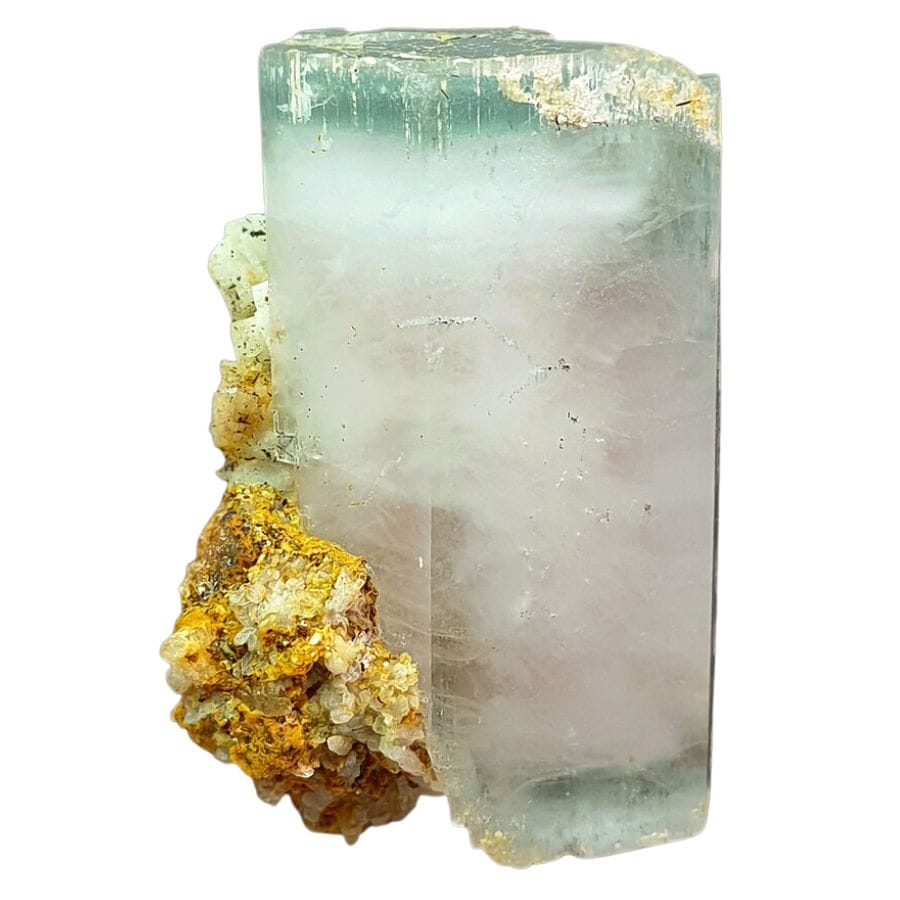
Beryl is a dazzling gemstone that comes in a variety of beautiful colors. The clear, colorless form of beryl is called goshenite, but when it has some color to it, that’s when things get exciting!
For example, when beryl is green, it’s known as emerald. When it’s blue, it’s called aquamarine.
This gemstone forms deep underground. Picture hot liquids moving through the Earth’s crust. As these liquids cool down, beryl starts to form. The different colors come from different elements that are present in those liquids.
Among the gemstones found in Missouri, beryl has its special place because of its charm and variety. People who know their gems get really excited when they spot beryl in the mix.
Aside from its pretty colors, beryl is tough and durable. This makes it perfect for jewelry like rings or necklaces. When someone wears beryl jewelry, it not only looks stunning but also lasts for a long time.
Where you can find beryl in Missouri
Chrysocolla
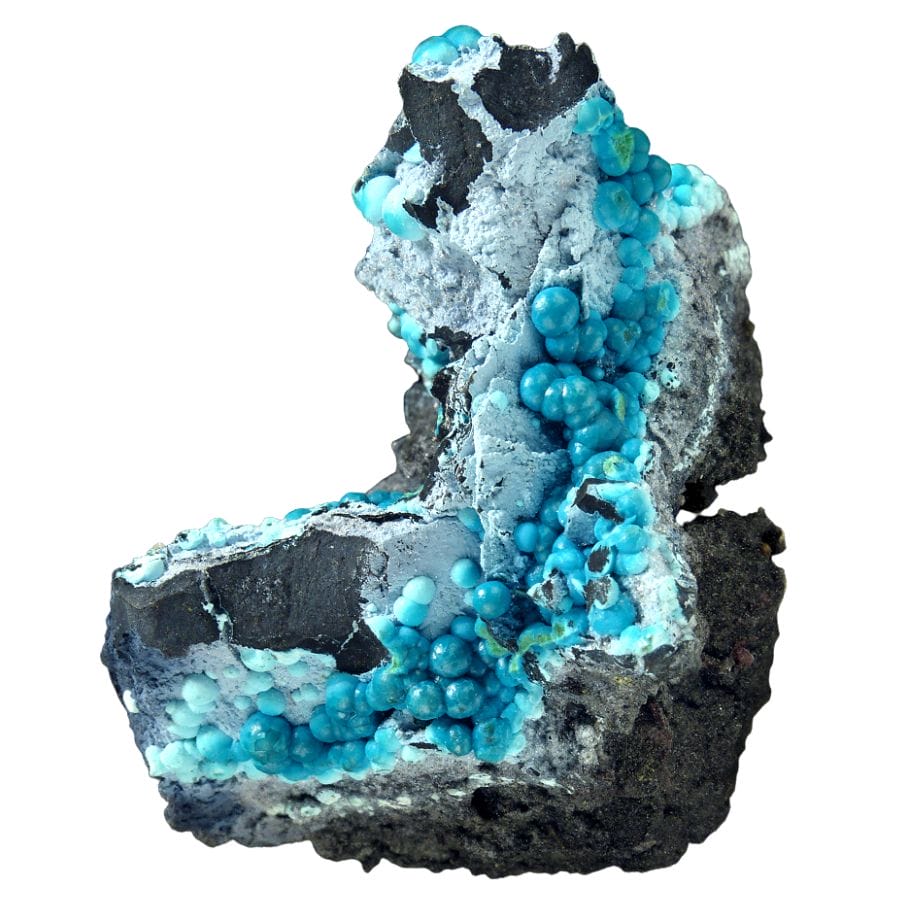
Chrysocolla is a dazzling gemstone with a vibrant blue-green hue that instantly grabs attention. This stone is often found in association with copper deposits, which gives it its fantastic color.
The formation of chrysocolla is an exciting tale of chemistry and patience. When water trickles through copper-bearing rocks, a reaction occurs. This reaction between the copper and the water forms chrysocolla over time.
While chrysocolla isn’t the most common stone you’d find in Missouri, its presence does add to the rich tapestry of the state’s geological wonders.
Jewelers and crafters love working with chrysocolla because it can be turned into stunning jewelry pieces. When polished, its vivid colors stand out even more, making it a favorite choice for necklaces, earrings, and rings.
Where you can find chrysocolla in Missouri
- Mine La Motte, Madison County
- Viburnum Trend Mining District
- Fredericktown, Madison County
Amethyst
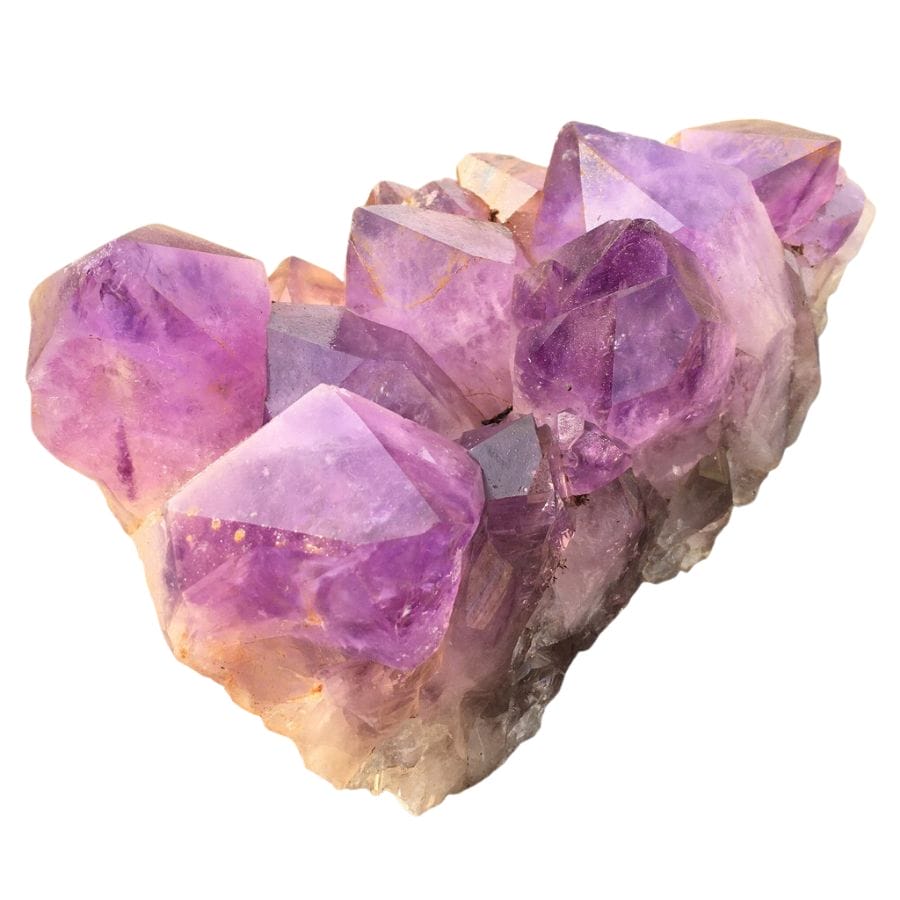
Amethyst is a stunning purple variety of quartz, and it’s a favorite among many who love rocks and minerals.
This beautiful stone gets its unique color from iron impurities and sometimes other trace elements. When amethyst is exposed to natural radiation over long periods, these impurities give the quartz its signature purple hue.
In Missouri, amethyst can be found as individual crystals or as clusters inside geodes. Geodes are round rocks with hollow centers that are lined with crystals. These geodes form when mineral-rich water fills cavities in rocks.
Over time, as the water evaporates, it leaves behind the minerals that grow into crystals.
Amethyst is highly valued for many reasons. Its stunning color makes it popular for jewelry, and it’s also used in home decor and for other decorative purposes.
Where you can find amethyst in Missouri
- Cherry Valley Mines, Steelville, Crawford County
- Dent County
- Moselle No. 10 Mine, Phelps County
Sphalerite
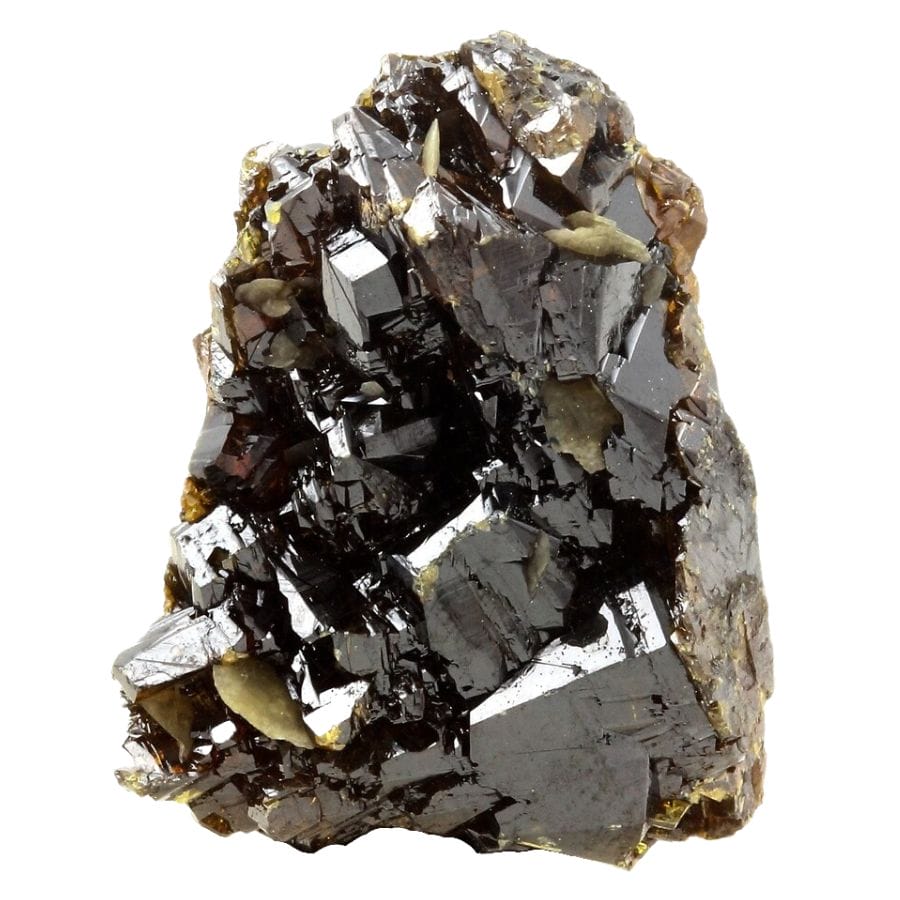
Sphalerite stands out in the world of minerals due to its intriguing characteristics and importance.
This mineral is primarily composed of zinc sulfide and can contain traces of other elements that influence its color, ranging from yellow-brown to black.
Sphalerite forms in a variety of geological environments, but most commonly in hydrothermal veins. As hot, mineral-rich water moves through cracks in the Earth, it cools and the minerals in the water begin to crystallize.
Over time, sphalerite is formed.
The value of sphalerite goes beyond its appearance. It is the primary ore of zinc, making it extremely important for industrial purposes. Zinc is used in many products, from galvanized steel to batteries and even sunscreen.
Where you can find sphalerite in Missouri
- Ellington, Reynolds County
- West Fork, Reynolds County
- Joplin, Jasper County
Quartz
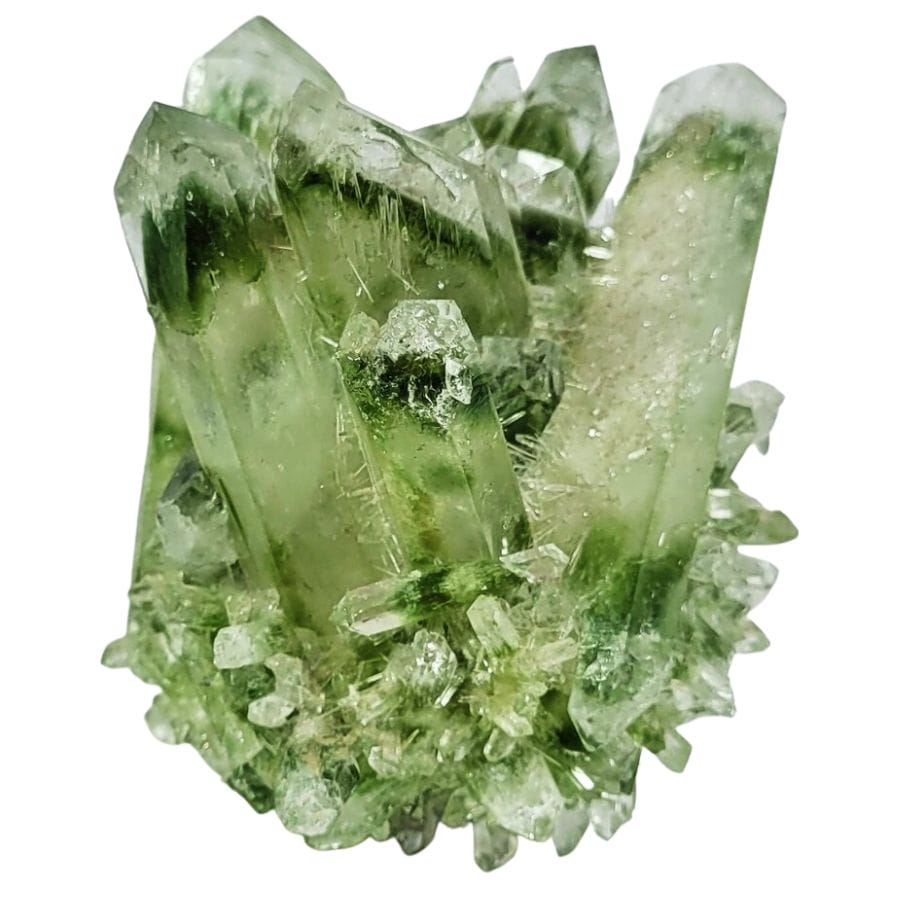
Quartz is a mineral that captures the attention of many with its sparkling clarity and diverse range of colors. Among the various crystals found in Missouri, quartz is undeniably one of the most recognized and admired.
This mineral is formed from a combination of oxygen and silicon, two of the most abundant elements in the Earth’s crust. As molten rock cools down, quartz begins to crystallize.
Depending on the environment and elements present during its formation, quartz can take on different colors.
From the milky white of common quartz to the deep purple of amethyst or even the sunny yellow of citrine, this mineral showcases nature’s ability to paint with a broad palette.
Quartz’s hard and durable nature makes it a popular choice for jewelry. Additionally, because of its unique electrical properties, quartz is used in various industries, from electronics to timekeeping.
Watches, radios, and many technological devices rely on the properties of quartz crystals to function.
Where you can find quartz in Missouri
- Bixby, Iron County
- The Ozarks
- Joplin, Jasper County
Galena
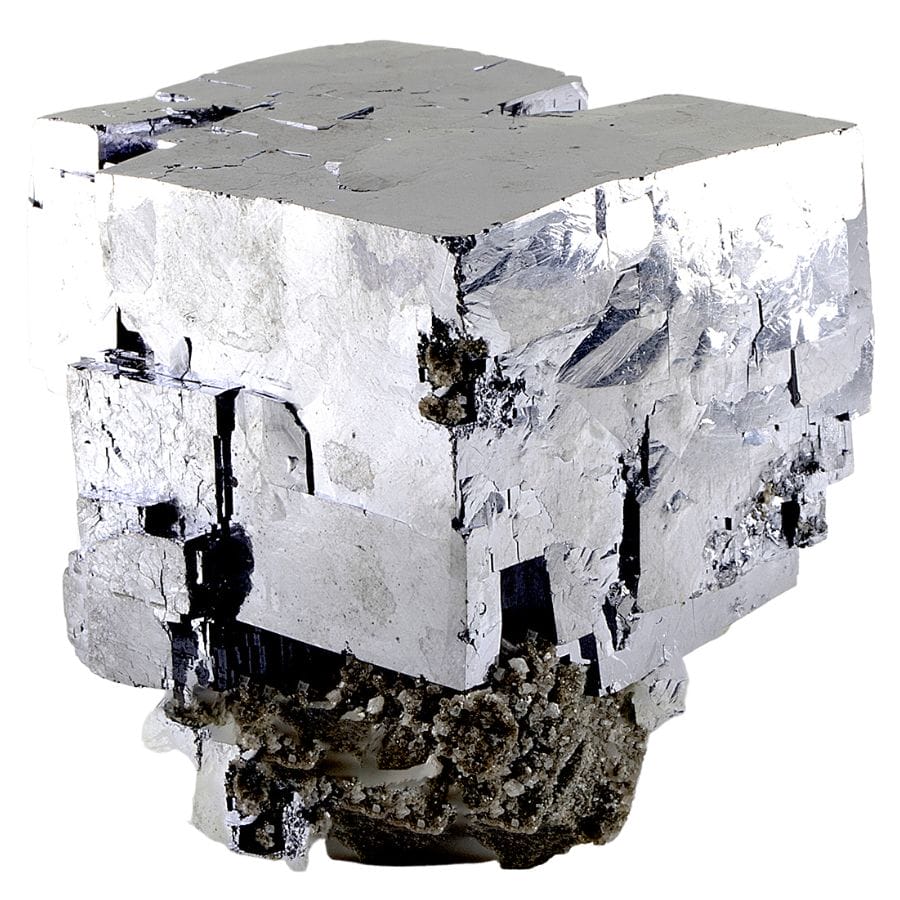
Galena is a standout mineral known for its distinctive metallic shine and cubic shape. It often captures attention with its silvery-gray hue. This mineral is primarily made up of lead sulfide, which gives it its weighty feel and metallic luster.
The formation of galena is closely tied to the Earth’s underground processes. Deep beneath the surface, where heat and pressure are at play, the elements lead and sulfur come together in just the right conditions.
Over time, these elements bond and crystallize, resulting in the growth of galena crystals.
Beyond its eye-catching appearance, galena holds significant value for practical reasons. It is one of the primary sources of lead, a metal with numerous applications.
From batteries to protective shields against radiation, the uses of lead extracted from galena are vast.
Additionally, traces of silver are often found within galena, adding to its value.
With its brilliant luster and vital industrial importance, galena holds a special place among the rocks and minerals of Missouri.
Where you can find galena in Missouri
- Lincoln, Benton County
- Decaturville crater, Camden County
- Graniteville, Iron County
Calcite
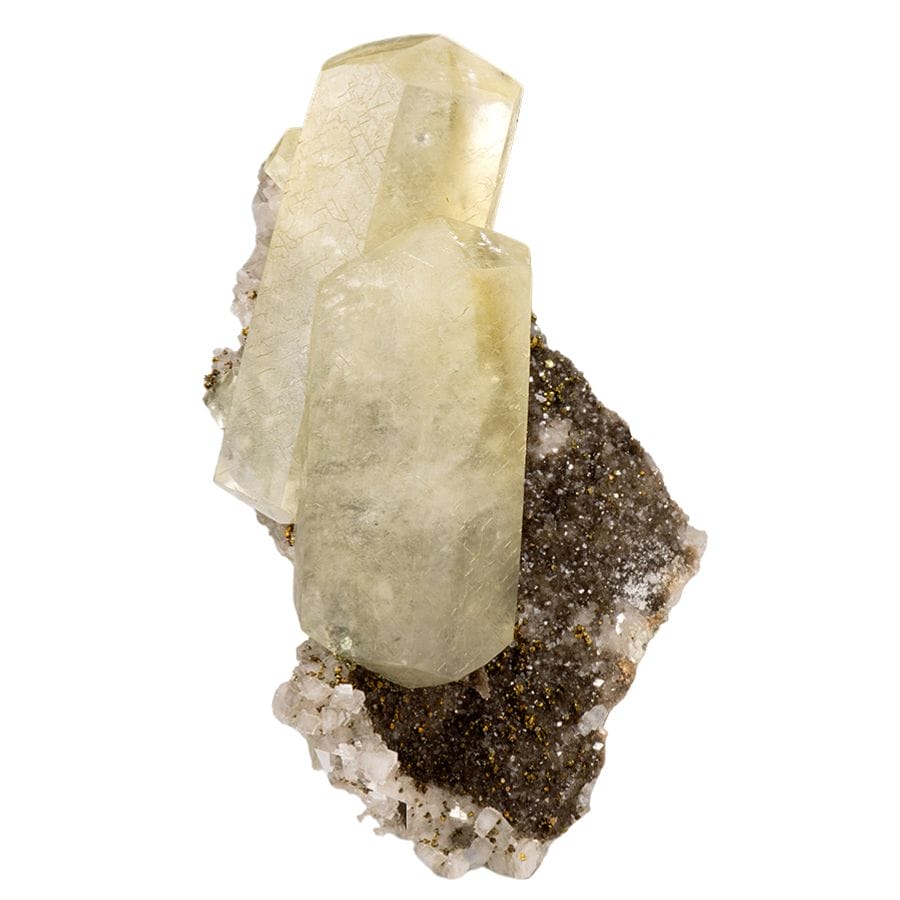
Calcite is a fascinating mineral with a unique set of characteristics. It’s often transparent or translucent in nature and usually grows into rhombohedral shapes.
In some instances, calcite can even display a rainbow of colors due to the presence of certain impurities.
When calcium-rich waters seep into crevices and begin to evaporate, they leave behind deposits. Over time, these deposits accumulate and harden to form calcite.
The mineral can be found in a variety of environments, from limestone caves to the shells of marine organisms.
The value of calcite extends beyond its looks. One of its notable properties is its ability to refract light, causing objects viewed through it to appear doubled.
This property, known as double refraction, has made calcite useful in certain optical instruments.
Moreover, calcite plays a key role in the construction industry as it’s a primary component of limestone, which is used to make cement.
This mineral adds another layer to the understanding of the rocks and minerals found in Missouri, showcasing the variety and depth of Missouri’s geology.
Where you can find calcite in Missouri
- Pleasant Hill
- Fabius River
- Defiance Quarry
Hematite

Hematite is a remarkable mineral, often captivating onlookers with its deep red or metallic gray hues. Among the variety of rocks found in Missouri, hematite stands out, not just because of its appearance but also due to its rich history and uses.
The formation of hematite typically occurs in areas with standing water or hot springs, or even in volcanic activity. Over time, as iron mixes with oxygen in the water, it gradually forms this dense mineral.
Once formed, hematite showcases a unique characteristic: when scratched across a rough surface, hematite leaves behind a reddish-brown streak, making it easily identifiable.
Hematite is a key source of iron, which plays an indispensable role in everyday life. Iron is used in everything from construction materials and vehicles to tools and appliances.
So, every time someone spots the shiny, metallic luster of hematite, they’re actually looking at the raw form of an element that powers much of modern civilization.
Where you can find hematite in Missouri
- Iron Mountain District
- St. Francois County
- Pea Ridge Mine, Washington County
The Best Locations For Crystal Mining in Missouri
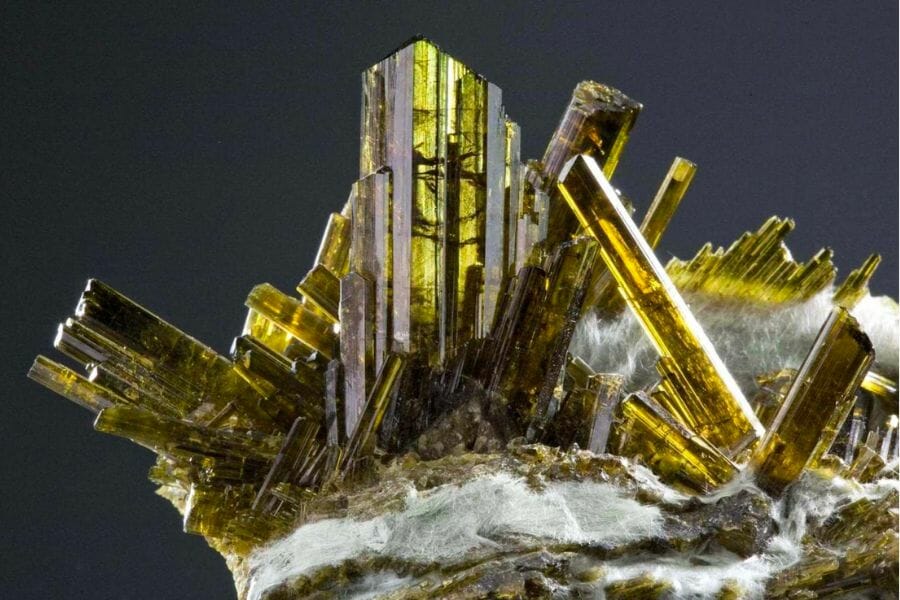
First, we’ll share with you our top recommended crystal mining sites here. We had the best of time and luck locating these natural wonders in these places:
Always Confirm Access and Collection Rules!
Before heading out to any of the locations on our list you need to confirm access requirements and collection rules for both public and private locations directly with the location. We haven’t personally verified every location and the access requirements and collection rules often change without notice.
Many of the locations we mention will not allow collecting but are still great places for those who love to find beautiful rocks and minerals in the wild without keeping them. We also can’t guarantee you will find anything in these locations since they are constantly changing.
Always get updated information directly from the source ahead of time to ensure responsible rockhounding. If you want even more current options it’s always a good idea to contact local rock and mineral clubs and groups
Grindstone Creek
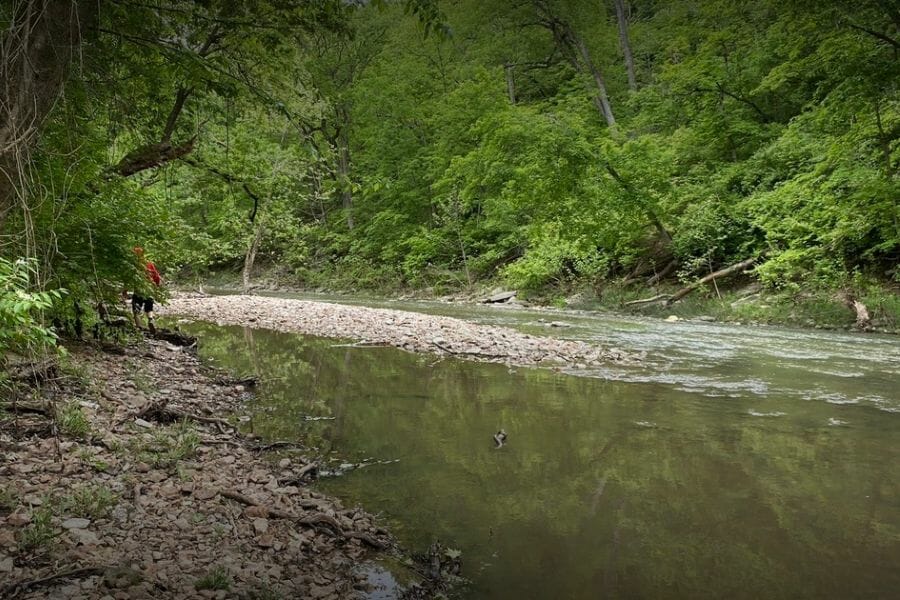
2011 Old 63 S. Columbia, MO 65201
Located near Columbia, Grindstone Creek was once a popular spot for Native American tribes to gather and trade minerals. Today, it’s a popular destination for rockhounds looking for crystals.
Flowing through a forested area with exposed rock formations, the creek and its surrounding areas are rich with different crystals. What’s best is that the creek is shallow and slow-moving, making it easy to navigate while searching for crystals.
When you visit Grindstone Creek, be sure to bring a sturdy rock hammer, chisels, and eye protection. You’ll also want to dress for the weather and wear sturdy shoes for hiking around it.
Where we found crystals around the Grindstone Creek
You can find the best samples of brown and white Calcite crystals if you explore the coal measures in the northwest portion of Grindstone Creek. Read our pricing guide if you’re wondering how much are crystals worth.
If you want REAL results finding incredible rocks and minerals you need one of these 👇👇👇
Finding the coolest rocks in isn’t luck, it's knowing what to look for. Thousands of your fellow rock hunters are already carrying Rock Chasing field guides. Maybe it's time you joined the community.
Lightweight, mud-proof, and packed with clear photos, it’s become the go-to tool for anyone interested discovering what’s hidden under our red dirt and what they've already found.
Join them, and make your next rockhounding trip actually pay off.
What makes it different:
- 📍 Find and identify 140 incredible crystals, rocks, gemstones, minerals, and geodes across the USA
- 🚙 Field-tested across America's rivers, ranchlands, mountains, and roadcuts
- 📘 Heavy duty laminated pages resist dust, sweat, and water
- 🧠 Zero fluff — just clear visuals and straight-to-the-point info
- ⭐ Rated 4.8★ by real collectors who actually use it in the field
Chariton River
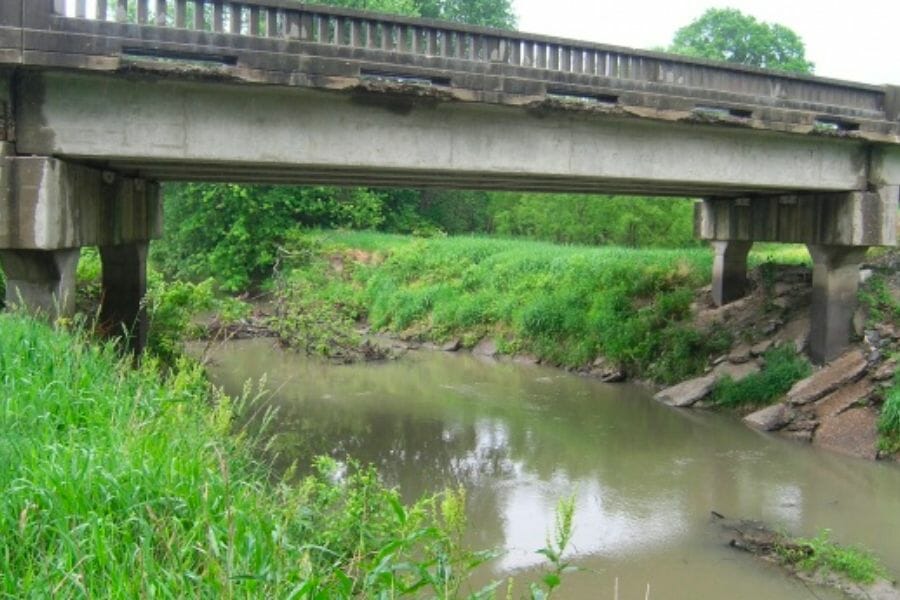
Chariton County, MO
The Chariton River has a rich history of being a valuable resource for early settlers. It’s been used for transportation, irrigation, and even powering mills. Today, it’s become a popular spot, not only for the usual outdoor recreation, but also for crystal hunting opportunies.
This location is known for its gravel bars that have been formed by the river’s flow over time, which has created an ideal environment for crystals to form and settle. And the best news is that the gravel bars are easily accessible and visible, so even beginner rockhounds can have success here.
If you want to visit here, be ready with the proper tools and equipment to find crystals. More importantly, be prepared to have an awesome crystal hunting adventure that you will remember for a lifetime!
Where we found crystals at Chariton River
We successfully found samples of Calcite and Quartz crystals in the Chariton River 2 miles north of the Macon County line, so we highly recommend you visit it, too.
Cole County
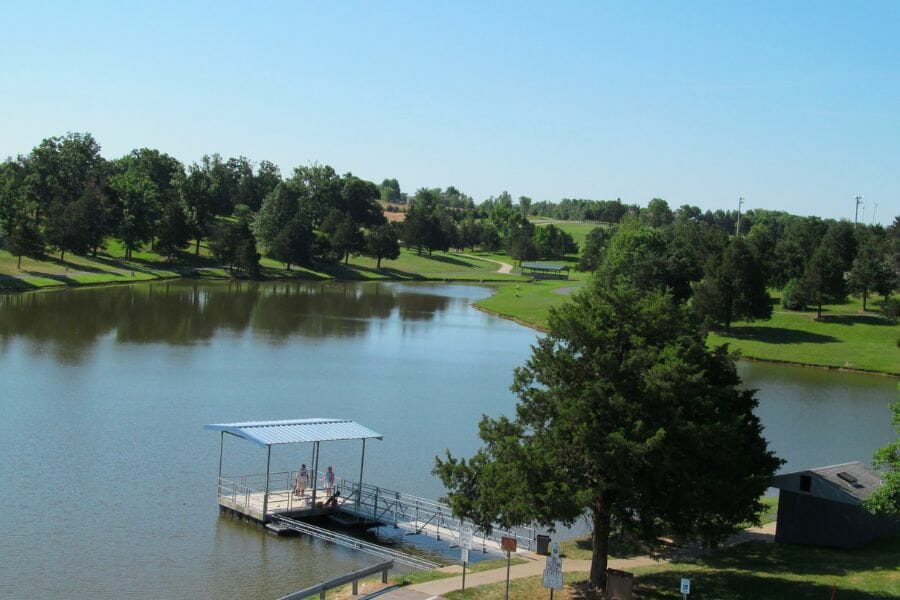
Cole County, MO
Located in central Missouri, Cole County has a rich history of mineral mining. In fact, its state capital of Jefferson City iwas once a hub for lead and zinc mining. Today, the area is home to several abandoned mines and quarries that are popular spots for crystal hunting.
The terrain in this county is hilly and rocky, which provides an ideal environment for crystals to form and settle. Some of the most popular spots for crystal hunting in Cole County include the Brewer Quarry and the Bonnots Mill Cave.
Since the area has a rich history of mineral mining, there are plenty of spots to search for crystals here. Additionally, its rocky terrain makes for a picturesque location to enjoy while you search for treasures. And, since Cole County is located in the heart of Missouri, it’s easily accessible from many parts of our state.
Where we found crystals at Cole County
There are a handful of different crystals you can find in this county: Calcite, Chalcopyrite, Hematite, Galena, Malachite, Pyrite, Quartz crystals and more if you explore the many regional mines here.
Rueppele Mine

Stanton, Franklin County, MO
Rueppele Mine is located in Maries County and was once a working lead mine in the late 1800s. While it’s is no longer in operation, it’s become a popular spot for rockhounds to search for crystals. The terrain around the mine is hilly and rocky, which provides an ideal environment for crystals to form and settle.
With its rich history of lead mining, the Rueppele Mine has plenty of pockets to search for crystals.Being in a more remote part of our state, you’ll also likely have a more peaceful and quiet rockhounding experience here.
Overall, the Rueppele Mine is a must-visit for crystal hunting here in Missouri!
Where we found crystals in Rueppele Mine
Since this is a mine, if you’re here, there’s a high chance you’re already near a crystal! Some of the best ones you can find are Amethyst, Azurite, Copper, Hematite, Marcasite, Pyrite, and Quartz crystals.
Our Other Favorite Places For Crystal Hunting
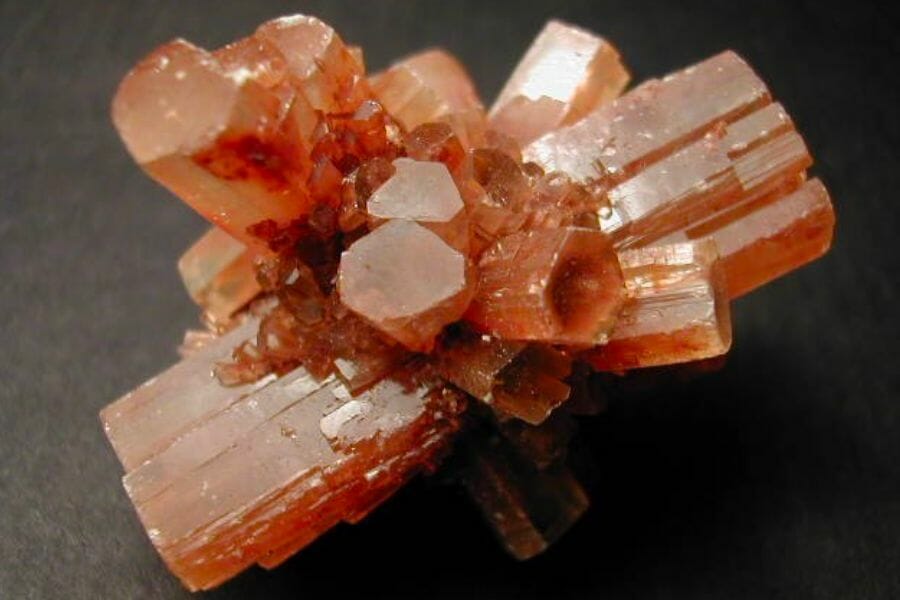
It’s no secret that our state is rich with different natural wonders, so it should come as no surprise that there are plenty other great places to do crystal hunting here. Some of these are also great places to find geodes in Missouri:
Where you can find crystals for free in Missouri
More often than not, the best places where you can find crystals require some fee. But there are plenty others where you don’t have to spend a dime. Here are some of them:
| County | Location |
| Adair | In the Chariton River, 2 miles north of the Macon County line |
| Bollinger | All county gravel pits, road cuts, excavations extending east through Cape Girardeau County to the Mississippi River |
| Dent | A filled sink deposit just southwest of Simmons Mountain |
| Henry | At the Warsaw quarry |
| Jackson | McClain quarry, at 63rd St. and Hwy. 350 in the Westerville |
| Knox | Kelly Lime-Rock quarry |
| Lincoln | South on Highway 61 at the Magruder Quarry |
| Maries | A filled sink iron deposit in Vienna |
| Ralls | At the Atlas cement quarry, south of town |
| St. Charles | In the limestone of the Defiance Quarry |
| Wayne | Shook Stone quarry |
Other great places to dig for crystals
If you’re open to pay a few bucks to find crystals, below is a list of some of the best pay-to-dig mines here. Remember, these fees may vary depending on the season (on some occasions, they might even be free!) so reach out first before heading out.
| County | Location |
| Buchanan | At the Eighty-Nine Mine and Sweetwater Mine |
| Cole | Regional mines, especially the Boaz, Old Circle and Eureka mines |
| Franklin | Area mines of Leslie, Morrelton, Saint Clair, and Sullivan |
| Greene | Area old mines east and west of town in Springfield |
| Howell | Laswell mine, near Summit Ave. and Canterbury Ave. |
| Iron | Magmont Mine and Buick Mine |
| Jasper | All great regional mines |
| Lawrence | Aurora Mining District area deposits and mines |
| Miller | At the Bolin Creek Mine |
| Phelps | At the Moselle Iron Mine and Buckland Mine |
| Texas | The Murphy barite mine, west of town |
How to find crystals in Missouri

A handful of our recommended places above cover wide areas, so to help you fine tune your search, here are the ares you can checkout when you visit here. When it comes to finding crystals, these places usually have the best ones to offer:
Quarries
Quarries are locations where stone, gravel, and sand are mined for construction purposes. Many of them are now abandoned, which makes them great places to search for crystals. One of the biggest advantages of searching in quarries is that they expose large areas of rock that would otherwise be hidden underground. This means that you’ll have a better chance of finding a large number of crystals in one spot. Quarries also have a lot of potential for finding unique and beautiful crystals that you might not find in other places.
Rivers and River Banks
Rivers are natural sources of erosion, which means that they constantly move and reshape the rocks and sediment along their paths. This makes them excellent places to search for crystals, as they can easily expose new specimens. Crystals found in rivers are often tumbled and polished by the water, which gives them a unique and beautiful appearance. Also, unlike some other crystal hunting locations, you don’t need any specialized equipment or permission to explore a river. All you really need is a keen eye, a little bit of patience, and a willingness to get your feet wet.
Streams and Creeks
Streams and creeks are natural waterways that flow through the countryside, often cutting through rocky terrain and exposing new crystals in the process. These waterways also tend to have more gentle currents and shallower depths compared to larger rivers, making them easier and safer to explore. You can actually find a wide variety of crystals here. The small and hidden nature of these waterways also means that you might have a better chance of finding something truly unique and special.
Missouri Crystal Mining Laws And Regulations
If you follow the local state collecting laws of Missouri, especially the ones implemented by the Missouri Department of Natural Resources (DNR), you will have no legal issues or problems crystal mining here. Primarily, make sure to obtain any necessary permits or permissions from concerned government offices and private individuals, such as the owner of any private land you’re planning to explore. Also, respect any restrictions in place to protect the environment and biodiversity of the area. Remember, by practicing responsible crystal hunting, you are helping make this activity sustainable here for years to come.
The Best Crystal Shops In Missouri

In many cases, finding crystals is no easy feat— it requires tons patience and hard work. If you’re somebody who prefers to go the easy, but surefire way to take home Missouri crystals, your best bet is by visiting the local crystal shops here. Check these out!
- Prospectors Crystals, Rocks & Gift Shop – 1640 Gravois Rd, High Ridge, MO 63049
- STL Rocks – 2003 Cherokee St, St. Louis, MO 63118
- Fall Creek Rock Shop – 11010 Dillon Outer Rd, Rolla, MO 65401
- Ashley Fay Crystals – 7574 MO-266, Springfield, MO 65802
- Blue Lavender Sky – 1462 N Grant Ave, Springfield, MO 65802
- Pathways – 11419 Concord Village Ave, St. Louis, MO 63123
- White Light Crystal Shoppe – 115 E Gregory Blvd, Kansas City, MO 64114
- Enchanted Attic – 304 S Main St, St Charles, MO 63301
- One Of A Kind – 1819 W 76 Country Blvd Suite E, Branson, MO 65616
- Spectrum A New Age Shop – 7827 N Oak Trafficway, Kansas City, MO 64118
Additional places to find crystals in nearby states
If you’ve already tried all of our recommendations above or are planning a trip out of the state, you should check out our guides for neighboring states:
- Crystals in Iowa
- Crystals in Illinois
- Crystals in Kentucky
- Crystals in Tennessee
- Crystals in Arkansas
- Crystals in Oklahoma
- Crystals in Kansas
- Crystals in Nebraska
If you have any recommendations we haven’t covered, please leave them in the comments below!



